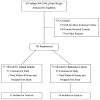Randomized trial of liberal versus restrictive guidelines for red blood cell transfusion in preterm infants
- PMID: 15930233
- PMCID: PMC2866196
- DOI: 10.1542/peds.2004-1884
Randomized trial of liberal versus restrictive guidelines for red blood cell transfusion in preterm infants
Abstract
Objective: Although many centers have introduced more restrictive transfusion policies for preterm infants in recent years, the benefits and adverse consequences of allowing lower hematocrit levels have not been systematically evaluated. The objective of this study was to determine if restrictive guidelines for red blood cell (RBC) transfusions for preterm infants can reduce the number of transfusions without adverse consequences.
Design, setting, and patients: We enrolled 100 hospitalized preterm infants with birth weights of 500 to 1300 g into a randomized clinical trial comparing 2 levels of hematocrit threshold for RBC transfusion.
Intervention: The infants were assigned randomly to either the liberal- or the restrictive-transfusion group. For each group, transfusions were given only when the hematocrit level fell below the assigned value. In each group, the transfusion threshold levels decreased with improving clinical status.
Main outcome measures: We recorded the number of transfusions, the number of donor exposures, and various clinical and physiologic outcomes.
Results: Infants in the liberal-transfusion group received more RBC transfusions (5.2 +/- 4.5 [mean +/- SD] vs 3.3 +/- 2.9 in the restrictive-transfusion group). However, the number of donors to whom the infants were exposed was not significantly different (2.8 +/- 2.5 vs 2.2 +/- 2.0). There was no difference between the groups in the percentage of infants who avoided transfusions altogether (12% in the liberal-transfusion group versus 10% in the restrictive-transfusion group). Infants in the restrictive-transfusion group were more likely to have intraparenchymal brain hemorrhage or periventricular leukomalacia, and they had more frequent episodes of apnea, including both mild and severe episodes.
Conclusions: Although both transfusion programs were well tolerated, our finding of more frequent major adverse neurologic events in the restrictive RBC-transfusion group suggests that the practice of restrictive transfusions may be harmful to preterm infants.
Figures
Comment in
-
Randomized trial of liberal versus restrictive guidelines for red blood cell transfusion in preterm infants.Pediatrics. 2005 Oct;116(4):1048-9; author reply 1049-50. doi: 10.1542/peds.2005-1581. Pediatrics. 2005. PMID: 16199722 No abstract available.
-
Red blood cell transfusion in neonates.Pediatrics. 2005 Dec;116(6):1609; author reply 1609-10. doi: 10.1542/peds.2005-1593. Pediatrics. 2005. PMID: 16322196 No abstract available.
-
Red blood cell transfusions in preterm infants: is there a difference between restrictive and liberal criteria?Pediatrics. 2006 Jan;117(1):257-8; author reply 258-9. doi: 10.1542/peds.2005-2360. Pediatrics. 2006. PMID: 16396895 No abstract available.
References
-
- Strauss RG. Transfusion therapy in neonates. Am J Dis Child. 1991;145:904–911. - PubMed
-
- Sacher RA, Luban NLC, Strauss RG. Current practice and guidelines for the transfusion of cellular blood components in the newborn. Transfus Med Rev. 1989;3:39–54. - PubMed
-
- Widness JA, Seward VJ, Kromer IJ, Burmeister LF, Bell EF, Strauss RG. Changing patterns of red blood cell transfusion in very low birth weight infants. J Pediatr. 1996;129:680–687. - PubMed
-
- Alagappan A, Shattuck KE, Malloy MH. Impact of transfusion guidelines on neonatal transfusions. J Perinatol. 1998;18:92–97. - PubMed
-
- Maier RF, Sonntag J, Walka MM, Liu G, Metze BC, Obladen M. Changing practices of red blood cell transfusions in infants with birth weight less than 1000 g. J Pediatr. 2000;136:220–224. - PubMed
Publication types
MeSH terms
Substances
Grants and funding
LinkOut - more resources
Full Text Sources
Other Literature Sources
Medical


